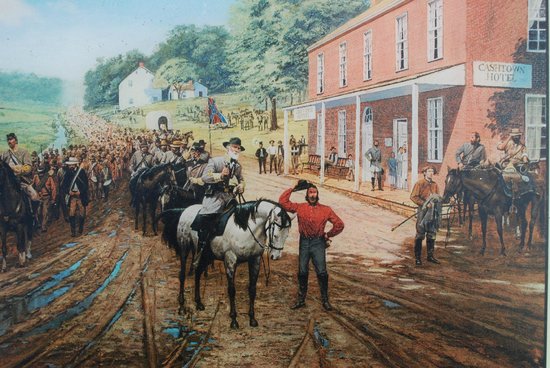Cashtown Inn History
The History
The Beginnings of Cashtown Inn

On the Road to Gettysburg
by George F. Skoch
Stand on the front porch of the Cashtown Inn and let your eyes roam along the gentle grade of Old Chambersburg Pike as it rises past apple orchards and open fields toward the wooded slope of Cashtown Gap in South Mountain. Then let your mind wander back to the Gettysburg Campaign in the summer of 1863, when Confederate troops filled this roadway.
To an unwary observer who stood in front of Cashtown Inn on June 29 of that year, it must have looked as if the whole Rebel army had emerged from the rough, forested ridgeline when the van of Lt. Gen. A.P. Hill’s Third Corps suddenly swung into view. Their crimson banners swayed with the liquid motion of marching soldiers, who were dressed in ragged butternut and gray. A gentle breeze carried with it the noise of rattling mess tins, the clanking of swords and bayonets, and the cheerful bantering of confident veterans on parade. To Cashtown Innkeeper Jacob Mickley, who witnessed the spectacle, it appeared as if “the entire force under Lee…passed within twenty feet of my barroom.”
Including a brief occupation by Confederate cavalry under Jeb Stuart in October 1862, this was the second time in less than a year that the Rebels had invaded Cashtown* (*Cashtown Inn gave its name to the peaceful crossroads village where the inn was built circa 1797. The name Cashtown was derived from the business practices of the first innkeeper, Peter Marck, who had insisted on cash payments for the goods he sold and the highway tolls he collected.)
During the Gettysburg Campaign, Robert E. Lee’s Army of Northern Virginia had surged across southern Pennsylvania at will until June 28. Late that day scouts informed Lee that the Union army was north of the Potomac River and coming his way. Quickly Lee ordered his scattered army to concentrate at Cashtown, which stood strategically on his supply line back to Virginia. Within hours, legions of lean Rebel soldiers descended from Cashtown Gap and shuffled past Jacob Mickley’s Inn.
As one of the oldest hostelries in the region, Cashtown Inn had served “for the entertainment of strangers and travelers” since 1815. That fateful summer of 1863, however, Cashtown Inn served hundreds of unwelcome strangers, including Confederate Gens. A.P. Hill, Henry Heth, and John D. Imboden. Suffering from a chronic ailment when he arrived at Cashtown at the head of his corps on June 29, the 37-year old Hill set up his headquarters in the relative comfort of Cashtown Inn. It was a good choice. For decades Cashtown Inn had been touted for its “healthy neighborhood; pure mountain air” and “daily bath” in fine waters from a natural spring flowing through the cellar. The cellar also included two giant brick ovens where Confederate commissaries could bake bread in abundance. (The spring and evidence of the brick ovens are visible today).
Cashtown itself was transformed into an armed camp for several days in late June and early July 1863, while the battle of Gettysburg raged just eight miles to the east. It was from there that the pivotal battle was launched when A.P. Hill sent Maj. Gen. Henry Heth’s division to Gettysburg for shoes and supplies. Cashtown Inn bustled with activity during this time while Confederate officers and their staffs were quartered here. A stable located next to the Inn (but no longer standing) was used to shelter the wounded, as were many of the homes in the vicinity. Also dotting the orchards and meadows surrounding the village were hundreds of Lee’s supply wagons and the cannons and carriages belonging to his artillery reserve.
Lee used many of these same vehicles to transport his wounded back to Virginia following his defeat at Gettysburg. Commander of the 17-mile long wagon train of misery, Brig. Gen. John Imboden made his headquarters at Cashtown Inn. On July 4, Imboden wrote, “About 4 pm the head of the column was put in motion near Cashtown and began the ascent of the mountain in the direction of Chambersburg.” It wasn’t until the next day when Imboden passed over South Mountain with the last of the wagons that peace returned to Cashtown.
(In previous) decades Cashtown Inn has been on the declining end of almost two centuries of service. In 1948 a by-pass constructed on a segment of the Lincoln Highway (Route 30) relegated Cashtown Inn to the backwash of tourist traffic. The Inn fell to disrepair and some ill-repute. Not long ago, for example, a previous owner of this Civil War landmark had considered sub-dividing it into low-income apartments.
Preservationists take heart, though. (t)hanks to the tireless efforts of … (former) owners Charles “Bud” Buckley and his wife Carolyn, Cashtown Inn is back, and is once again providing for the “entertainment of strangers and travelers.”… – George F. Skoch
